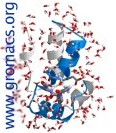 |
g_hbondMain Table of Contents |
VERSION 3.2.0
Sun 25 Jan 2004
| VERSION 3.2.0 |
g_hbond computes and analyzes hydrogen bonds. Hydrogen bonds are determined based on cutoffs for the angle Donor - Hydrogen - Acceptor (zero is extended) and the distance Hydrogen - Acceptor. OH and NH groups are regarded as donors, O is an acceptor always, N is an acceptor by default, but this can be switched using -nitacc. Dummy hydrogen atoms are assumed to be connected to the first preceding non-hydrogen atom.
You need to specify two groups for analysis, which must be either identical or non-overlapping. All hydrogen bonds between the two groups are analyzed.
If you set -shell, you will be asked for an additional index group which should contain exactly one atom. In this case, only hydrogen bonds between atoms within the shell distance from the one atom are considered.
It is also possible to analyse specific hydrogen bonds with -sel. This index file must contain a group of atom triplets Donor Hydrogen Acceptor, in the following way:
[ selected ]
20 21 24
25 26 29
1 3 6
Note that the triplets need not be on separate lines.
Each atom triplet specifies a hydrogen bond to be analyzed,
note also that no check is made for the types of atoms.
-ins turns on computing solvent insertion into hydrogen bonds. In this case an additional group must be selected, specifying the solvent molecules.
Output:
-num: number of hydrogen bonds as a function of time.
-ac: average over all autocorrelations of the existence
functions (either 0 or 1) of all hydrogen bonds.
-dist: distance distribution of all hydrogen bonds.
-ang: angle distribution of all hydrogen bonds.
-hx: the number of n-n+i hydrogen bonds as a function of time
where n and n+i stand for residue numbers and i ranges from 0 to 6.
This includes the n-n+3, n-n+4 and n-n+5 hydrogen bonds associated
with helices in proteins.
-hbn: all selected groups, donors, hydrogens and acceptors
for selected groups, all hydrogen bonded atoms from all groups and
all solvent atoms involved in insertion.
-hbm: existence matrix for all hydrogen bonds over all
frames, this also contains information on solvent insertion
into hydrogen bonds. Ordering is identical to that in -hbn
index file.
-dan: write out the number of donors and acceptors analyzed for
each timeframe. This is especially usefull when using -shell.
| option | filename | type | description |
|---|---|---|---|
| -f | traj.xtc | Input | Generic trajectory: xtc trr trj gro g96 pdb |
| -s | topol.tpr | Input | Generic run input: tpr tpb tpa xml |
| -n | index.ndx | Input, Opt. | Index file |
| -g | hbond.log | Output, Opt. | Log file |
| -sel | select.ndx | Input, Opt. | Index file |
| -num | hbnum.xvg | Output | xvgr/xmgr file |
| -ac | hbac.xvg | Output, Opt. | xvgr/xmgr file |
| -dist | hbdist.xvg | Output, Opt. | xvgr/xmgr file |
| -ang | hbang.xvg | Output, Opt. | xvgr/xmgr file |
| -hx | hbhelix.xvg | Output, Opt. | xvgr/xmgr file |
| -hbn | hbond.ndx | Output, Opt. | Index file |
| -hbm | hbmap.xpm | Output, Opt. | X PixMap compatible matrix file |
| -dan | danum.xvg | Output, Opt. | xvgr/xmgr file |
| option | type | default | description |
|---|---|---|---|
| -[no]h | bool | no | Print help info and quit |
| -nice | int | 19 | Set the nicelevel |
| -b | time | -1 | First frame (ps) to read from trajectory |
| -e | time | -1 | Last frame (ps) to read from trajectory |
| -dt | time | -1 | Only use frame when t MOD dt = first time (ps) |
| -[no]ins | bool | no | Analyze solvent insertion |
| -a | real | 30 | Cutoff angle (degrees, Donor - Hydrogen - Acceptor) |
| -r | real | 0.35 | Cutoff radius (nm, X - Acceptor, see next option) |
| -[no]da | bool | yes | Use distance Donor-Acceptor (if TRUE) or Hydrogen-Acceptor (FALSE) |
| -abin | real | 1 | Binwidth angle distribution (degrees) |
| -rbin | real | 0.005 | Binwidth distance distribution (nm) |
| -[no]nitacc | bool | yes | Regard nitrogen atoms as acceptors |
| -[no]contact | bool | no | Do not look for hydrogen bonds, but merely for contacts within the cut-off distance |
| -shell | real | -1 | when > 0, only calculate hydrogen bonds within # nm shell around one particle |
| -[no]dump | bool | no | Dump all hydrogen bond ACFs (maximum 1000) in a single xvg file for debugging |
| -max_hb | real | 0 | Theoretical maximum number of hydrogen bonds used for normalizing HB autocorrelation function. Can be useful in case the program estimates it wrongly |
| -[no]merge | bool | yes | H-bonds between the same donor and accepter, but with different hydrogen are treated as a single H-bond. Mainly important for the ACF. |